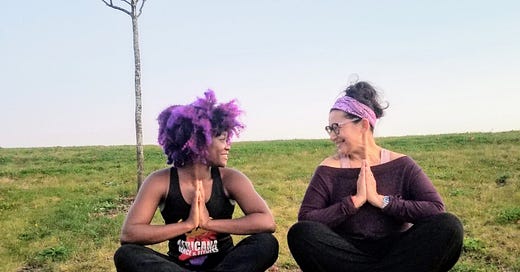How can I be compassionate when others aren't?
How Practicing Interbeing Offers Clarity and Connection Despite Differences
I was teaching mindfulness to executives at a business school recently when someone asked a question that resonated deeply with my own journey: "What do we do when we're practicing compassion but the people around us aren't? How can we be compassionate when others aren't?"
I acknowledged how frustrating and futile that feels. What's the point of practicing compassion when others aren't responding or changing? This is actually one of the core challenges I've dedicated years to working with.
My Town Council Experience
My journey with this question began during my time on the town council. In those meetings, we'd often get locked into our positions, completely stop listening to each other, and perceive everything through the lens of our judgments. We weren't really hearing each other at all.
That's when I started practicing interbeing – a practice to recognize our interdependence, which naturally evokes true compassion. Here's the thing I realized: Often when we think we're being compassionate, we're focusing on others' needs but there is an expectation that they will in turn change their perspective to be more agreeable with ours. When they stay focused on their own views, we end up feeling depleted and resentful.
This approach, which we might call "strategic compassion," isn't based on a deeper understanding of our interconnectedness but is dictated by an agenda. The expectation is usually subtle and unconscious – a hope that our compassionate gesture will somehow lead others to see things our way. When it doesn't happen, disappointment follows.
The Interbeing Approach
In interbeing, we start differently. We first acknowledge our own needs, values, and intentions, making room to listen to what's emerging within us about the situation. Only once we feel connected with what's important to us – without judgment – do we shift our attention to the other person.
For example, with my fellow councilor, I would recognize that:
She cares about our town, just like I do
She is doing her best, just like I am
She wants to be happy and serve her community, just like I do
In this, we are the same.
Feeling Compassion in Your Body
When I genuinely felt our shared humanity in my body, I would notice a softening of the rigid judgments and beliefs I was holding. Then I could open my mind to receiving new information. I would wonder: What did she know that I didn't that made her feel this way?
This invited genuine curiosity. Instead of forcing my point of view, I would ask more questions. A shift in my beliefs changed my perspective and behavior to curiosity, which then shifted how other councilors responded to me. We would have a more informative and fulfilling exchange.
What I've found remarkable about this practice is how these subtle shifts in your perspective can have a profound impact on how you show up, which will then influence how the other person responds. The energetic change is real – when you move from judgment to curiosity, from separation to connection, people can sense it even if they can't name it. The entire dynamic of the interaction transforms.
Did It Work?
Did this change our votes? Not always.
Did it change how I felt about my fellow councilors? Absolutely! And it often changed the quality of our conversations and behavior toward each other.
It's not an easy or clear process always, but just the intention to be guided by our interbeing is enough to bring clarity about the next step we can take.
Key Takeaways About True Compassion
Let me share some core takeaways I've discovered through this practice:
We're wired for judgment. Our brains naturally categorize people as either "in our group" or "other." We readily feel empathy for those we consider similar to us, but often struggle with those we see as different.
Our beliefs can distort reality. Once we categorize someone as "other," we tend to view them through a lens of assumptions and judgments that limit our ability to see them clearly.
True compassion isn't about being nice or strategic. Compassion doesn't mean simply being kind or catering to others' needs at the expense of our own. It's also not a strategy to listen to others in exchange for being heard by them. Real compassion comes without these hidden agendas or expectations.
Compassion is understanding interconnection. Real compassion comes from recognizing our interdependence and acting in ways that benefit everyone involved.
We can't force compassion. We can't think our way to compassion or simply command ourselves to feel it.
Compassion is an embodied practice. When we practice seeing our similarities and listen within, we open to a bigger reality. We feel this in our bodies as a softening or release that creates space to truly listen, understand, and connect with others.
Try It Yourself
See for yourself with the interbeing practice I offered to Mindful magazine as part of their series featuring the ten powerful women of the mindfulness movement in 2025. Whether you're dealing with difficult colleagues, family members, or community tensions, this practice offers a way forward that honors both your needs and our shared humanity.
If you'd like to practice and understand the nuances of compassion and other mindfulness skills for real-world shifts in your thinking and decisions, please check out my upcoming immersive program based on my book, Return to Mindfulness.
What situations in your life might benefit from this approach? I'd love to hear about your experiences.
Thanks to my friend
, who noted this in response to the interbeing practice that reminded me of the question asked by the executives in the business school:…the subtle shifts in your perspective can have a big impact on how you show up which will then impact how the other person responds.





